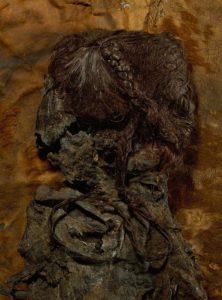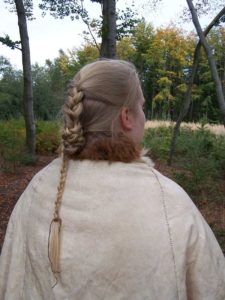A couple of weeks ago, a young man who follows me on Instagram recommended a magazine that is dedicated to dark folklore. I want to send him a cookie bouquet or maybe some free healthcare because had he not mentioned Hellebore on his feed, I might not have heard of it at all, let alone found out about it in time to discuss it for Oddtober2020. Living in your own little world has its drawbacks, and basically all the youngsters who follow me on Instagram expose me to all kinds of new media, ensuring I will always have fodder for OTC. The kids are alright and most of the time they have really interesting taste.
Hellebore is a fascinating journal. The magazine’s subtitle is “A Summoning of Ancient Terrors” and so it is. When I placed an order, only the first two issues were available. Number one is the “Sacrifice” issue and number two is the “Wild Gods.” It is a biannual magazine, released at Beltane and Samhain, and since I placed my order, the third installment, the “Malifice” issue became available for pre-order. I am sort of bummed that I will not be able to get the third magazine in time for this year’s Oddtober because, of the three issues, it is the one most relevant to my specific interests.
But that’s a very small complaint because the first two issues are definitely worth talking about. But I now know I already have an entry planned for Oddtober 2021. Just sayin’…
It’s been a while since I wallowed in the occult, and what better time to solve that problem? Walloween, my friends.
I’m only going to discuss the first volume, the “Sacrifice” edition, this go around but it should be mentioned that both issues are deeply interesting. At the time of this writing, Hellebore is offering all three in the “Wyrd Sisters” bundle at a reduced price. Definitely worth the purchase and shipping price, but if you’re in the UK or the US also have a look at the stockists list just in case a book store near you carries the magazine.
As is likely obvious, the “Sacrifice” issue handles the topic of sacrifice and how it manifests throughout history, and in this context history is confined mostly to the British Isles and some Northern European locations. Among the eight articles in this 68-page magazine are:
- A look at stone circle sites in the UK and discussion regarding their purpose, which was possibly serving as locations for human sacrifice (Druids enter stage left) and larger, megalith sites, like Stonehenge, were possibly mass cremation sites.
- An interesting literary discussion about the man who was the inspiration for the creepy and wicked Mr. Abney in M.R. James’ story, “Lost Hearts.”
- A brief examination of various types of animal sacrifices throughout history.
- A discussion of the perception of English small towns as places where the old gods and old ways reign supreme and the casual visitor may want to bear that in mind if they find themselves wanting to disparage the rural inhabitants of seemingly backward burgs. This article, “From His Blood the Crops Would Spring” by Maria J.Perez Cuervo, was deeply interesting to me. Earlier this week I happened across a channel that is essentially a computer reading some of the creepier threads from 4-chan boards, usually /x/. I had listened to this video on occult happenings in Yorkshire, including what appeared to be wholesale sacrifice of horses as well as possible child sacrifice.* That level of happenstance generally means I will want to talk a topic to death, so to speak, but I don’t know enough about this topic to hold forth at length. I will definitely be sorting through the references Cuervo used for the article because this was a “worth the price of admission” story.
This journal actually has two articles that are worth buying the magazine for – the Cuervo article above and “The Bodies in the Bog” by John Reppion. I’m focusing on Reppion’s article because I know a thing or two about “bog bodies” and because I appreciate Reppion’s scholarly attempt to shed light on how some of these people actually died versus the very salacious assertions of human sacrifice offered up with every newly discovered bog body. What initially looks like a body buried with its limbs severed could very easily be a person whose limbs were cut off by the peat-cutters who discovered the corpse. What appears to be a garotte may just be a leather necklace that shrank over the centuries.
But Reppion is also willing to cede that many bog bodies are, indeed, the results of human sacrifice, or at the very least capital punishment with a disregard for burial customs. He specifically mentions the Haraldskaer Woman, found in 1835 in Jutland, Denmark, so well-preserved that she was initially believed to be a recent murder victim (as are many bog bodies, it must be said). It was believed she was Queen Gunnhild of Norway, who lived between 910-980 AD. In the Jomsvikinga Saga, it is said that she was the wife of Eric Bloodaxe and was the mother of many subsequent kings, but Harald Bluetooth of Denmark had her drowned in the bog on his estate. So certain that they had found the body of this historical heroine, the then-king of Denmark and Norway ordered an elaborate burial casket for the bog woman. When subjected to modern testing, it was revealed that the bog woman was definitely not Gunnhild. The Haraldskaer Woman lived around 500 BC. And if she lived in 500 BC, during a time when cremation was the preferred burial method, it seems rather likely that there was a significant reason why her body was sunk in a bog, with branches placed atop her limbs to hold her in place. A faint groove along her neck points in the direction that she was a victim of human sacrifice.
I love stories of bog bodies. They seem to follow a script. Manual workers find the corpse as they are digging up or cutting into something, they think it is a murder victim, the academics gather and declare the corpse to be a specific type of bog person, only to have academics gather later and declare all the earlier information null and void. I became interested in bog people when I was in college. I read about one for the first time in a Margaret Atwood story that framed the breakup of a student and the older professor who should have known better around the discovery of a bog body. The story, called simply “The Bog Man” was the first time I recall knowing about such things, but I also recall that bog people played a big role in some of Seamus Heaney’s poetry. Regardless, it wasn’t science that sparked such an interest, which probably goes without saying.
I have a favorite bog person – which also probably goes without saying because of course I have a favorite – and it’s the Elling Woman.

She was found in Denmark in 1938, and she’s been overshadowed in bog folk-lore by the discovery of the Tollund Man, found in 1950 about 200 feet away from where her body was discovered. Both bodies were killed by hanging, and the positioning of their bodies indicates they were ritual sacrifice victims rather than people subjected to capital punishment. Initially, it was believed the Elling Woman was a young man, but a later scan of her pelvis revealed her sex.
This is a recreation of both the braid as well as the cloak the Elling Woman was found wearing. You can find tutorials on YouTube that take you through the process of plaiting your hair up like the Elling Woman. And yes, I’ve attempted this braid and sort of got it but I suspect I am just not Nordic enough to pull it off. You need to be very tall and in possession of at least one embroidered dress from the set of Midsommar to wear hair like this without looking a bit odd.
You know the world is a fascinating place when you can read about the disturbing enthusiasm a reclusive Texan has for a charming Dutch woman’s recreation of a hairstyle worn by an Iron Age woman hanged for cultural reasons we will likely never know then stuffed into a bog. But mostly, yeah, I selected the bog men article so I could talk about this specific bog woman because I tried to replicate the hairstyle during a long spell of jittery insomnia. Not even close to the worst reason I’ve chosen a topic for this site.
All in all, Hellebore has proven to be a righteous purchase. In the off-chance my copy of the “Malefice” edition crosses the pond fast enough for me to talk about it for Oddtober2020, I’ll devour it in one sitting and write it up. Otherwise meet me back here next year.
*Beware: Any time missing children are mentioned from anything related to a /chan, you are no more than an Internet inch away from falling down a deep and relentless Q-Anon rabbit hole, which is less a rabbit hole than a gaping chasm in the time-space continuum from which you will not emerge for months, if you’re lucky. Don’t say I didn’t warn you.
